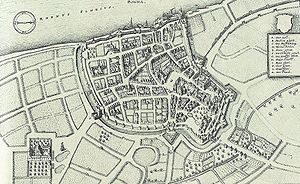Siege of Bonn (1673)
| date | November 3 to November 12, 1673 |
|---|---|
| place | Bonn |
| output | Defeat of France |
| consequences | The French lose their supply route to the Netherlands |
| Parties to the conflict | |
|---|---|
| Commander | |
|
From Landsberg , Reveillon |
William III.
|
Dutch War (1672–1678 / 79)
Solebay - First Schooneveld - Second Schooneveld - Texel - Bonn - Maastricht - Sinsheim - Seneffe - Enzheim - Türkheim - Sasbach - Konzer Bridge - Stromboli - Augusta - Palermo - Kokersberg - Philippsburg - Maastricht - Valenciennes - Tobago - Cassel - Freiburg - Ypres - Rheinfelden - Saint-Denis
The siege of Bonn occurred from November 3 to 12, 1673 as part of the Dutch War .
Prehistory and course
The city was the main fortress of the allies Kurköln and France . After the Catholic Emperor Leopold I had long hesitated German for French conquests cities (Wesel, Rhine Bergen, Emmerich, Rees, Soest and Hoxter) in alliance with the Protestant Dutch States-General against the French king Louis XIV. To put up a fight, was Probably the capture of Colmar (Alsace) and above all Triers (August 1673), the state capital of the loyal Elector Karl Kaspar von der Leyen , decisive for giving up the pro-France policy. After France's attack on the Spanish Netherlands , the Republic of the Netherlands and the aforementioned German cities, the first major offensive by the Emperor, the Spaniards and the Dutch for the French was directed completely surprisingly against Bonn. After a few defeats, the French army was already on the retreat when troops from the Netherlands under William III. , from Spain and from the Holy Roman Empire under the imperial military leader Raimondo Montecuccoli advanced towards Bonn to cut off the French their supply routes over the Rhine.
The Cologne elector and archbishop Maximilian Heinrich fled his residence city of Bonn to Cologne. On November 3, 1673, an advance guard of the imperial troops under Colonel Ottone Enrico del Caretto , Marquis di Grana, reached Plittersdorf near Bonn. Shelling began on November 8th. The occupation of Bonn under their commandant, the Brigadier Ravillon, and the Oberwachtmeister and Kurkölner city commandant of Landsberg capitulated on November 12, 1673. They received free withdrawal and moved with two cannons to Neuss and Königswerth . The new commander was the Marquis of Grana .
consequences
As a result of the conquests, the elector of Cologne and the prince-bishop of Munster were forced to negotiate peace with the Netherlands. On April 22, 1674, Munster made peace, on May 11, 1674, Kurköln. France not only lost two allies, but could no longer supply its troops in the Netherlands via the Rhine. After a lot of arson they withdrew. England was no longer interested in a war with the Dutch either and began peace negotiations.
When they withdrew, the French also had to leave a modern ship bridge ( Gierponte ) behind in Bonn.
Known victims
- Kurt Christoph von Königsmarck , Swedish field warrior and Dutch lieutenant general
literature
- Franz H. Ungewitter: History of the Netherlands. Volume 1: History of the Netherlands up to and including the year 1830. Hinrichs, Leipzig 1832, p. 186, ( digitized version ).
- Georg B. Depping : History of the war of the Munster and Cölner, in alliance with France, against Holland in the years 1672, 1673 and 1674. Theissing, Munster 1840, pp. 199-292, ( digitized ).

